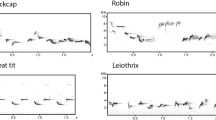Abstract
Victory displays are behaviours that occur after the conclusion of a signaling contest, performed solely by the contest winner. Victory displays may reinforce the dominance of the winner either to the loser or to other conspecifics within signaling range. Victory displays are poorly studied despite the significant consequences that post-conflict behaviour may have on the individuals involved. We examined the period immediately following 50 territorial countersinging contests between males in 10 neighbourhoods of black-capped chickadees (Poecile atricapillus) of known dominance rank. We characterized the post-contest singing behaviour of chickadees and evaluated whether post-contest behaviour is consistent with victory displays. Using a 16-microphone acoustic location system to simultaneously record entire neighbourhoods of breeding chickadees, we isolated 50 dyadic countersinging contests and measured the vocal behaviour of the contestants in the minutes following each interaction. Eighty-six percent of contests were followed by a period of solo singing by one of the contestants, while 14% were followed by silence. The post-contest singer was most often the contestant who held a subordinate dominance position in the previous winter’s dominance hierarchy; dominant males performed post-contest song bouts significantly less often. Asymmetry in overlapping between contestants did not predict which bird sang a post-contest bout. However, in a significant majority of cases, the post-contest singer was pitch-matched by his opponent during the contest more than he pitch-matched his opponent. Our results indicate that male chickadees do not perform acoustic victory displays after countersinging contests. In contrast, the post-contest behaviour of territorial chickadees is more consistent with a “loser display”.




Similar content being viewed by others
References
Aureli F (1992) Post-conflict behaviour among wild long-tailed macaques (Macaca fascicularis). Behav Ecol Sociobiol 31:329–337
Bower JL (2000) Acoustic interactions during naturally occurring territorial conflict in a song sparrow neighborhood. PhD thesis, Cornell University, Ithaca, USA
Bower JL (2005) The occurrence and function of victory displays within communication networks. In: McGregor PK (ed) Animal communication networks. Cambridge University Press, Cambridge
Christie PJ, Mennill DJ, Ratcliffe LM (2004) Pitch shifts and song structure indicate male quality in the dawn chorus of black-capped chickadees. Behav Ecol Sociobiol 55:341–348
Fitzsimmons LP, Foote JR, Ratcliffe LM, Mennill DJ (2008) Frequency matching, overlapping and movement behaviour in diurnal countersinging interactions of black-capped chickadees. Anim Behav (in press), DOI 10.1016/j.anbehav.2007.11.006
Grafe TU, Bitz J (2004) An acoustic postconflict display in the duetting tropical boubou (Laniarius aethiopicus): a signal of victory? BMC Eco 4:1
Kazam AJ, Aureli F (2005) Redirection of aggression: multiparty signaling within a network? In: McGregor PK (ed) Communication networks. Cambridge University Press, Cambridge, pp 191–219
Matos RJ, Schlupp I (2005) Performing in front of an audience: signalers and the social environment. In: McGregor PK (ed) Animal communication networks. Cambridge University Press, Cambridge
McGregor PK (2005) Introduction. In: McGregor PK (ed) Animal communication networks. Cambridge University Press, Cambridge
Mennill DJ, Otter KA (2007) Status signaling and communication networks in chickadees: Complex communication with a simple song. In: Otter KA (ed) Ecology and behavior of chickadees and titmice. Oxford University Press, Oxford
Mennill DJ, Ratcliffe LM (2004a) Do male black-capped chickadees eavesdrop on song contests? A multi-speaker playback experiment. Behaviour 141:125–139
Mennill DJ, Ratcliffe LM (2004b) Overlapping and matching in the song contests of black-capped chickadees. Anim Behav 67:441–450
Mennill DJ, Ratcliffe LM, Boag PT (2002) Female eavesdropping on male song contests in songbirds. Science 296:873
Mennill DJ, Boag PT, Ratcliffe LM (2003) The reproductive choices of eavesdropping female black-capped chickadees, Poecile atricapillus. Naturwissenschaften 90:577–582
Mennill DJ, Burt JM, Fristrup KM, Vehrencamp SL (2006) Accuracy of an acoustic location system for monitoring the position of duetting tropical songbirds. J Acoustic Soc America 119:2832–2839
Otter KA, Ratcliffe L, Njegovan M, Fotheringham J (2002) Importance of frequency and temporal song matching in black-capped chickadees: evidence from interactive playback. Ethology 108:181–191
Peake TM (2005) Eavesdropping in communication networks. In: McGregor PK (ed) Animal communication networks. Cambridge University Press, Cambridge, pp 13–37
Ratcliffe LM, Mennill DJ, Schubert KA (2007) Social dominance and fitness in black-capped chickadees. In: Otter KA (ed) Ecology and behavior of chickadees and titmice. Oxford University Press, Oxford
Todt D, Naguib M (2000) Vocal interactions in birds: the use of song as a model in communication. Adv Study Behav 29:247–295
Acknowledgement
We thank J. Baldock, R. Bull, S. Doucet, R. Jamieson, A. McKellar, D. Potvin, and K. Winger for field assistance. We thank the Curtis, Lundell, Warren, Weatherhead-Metz, and Zink families, for access to property, and the staff of Queen’s University Biological Station for logistical support. We thank J. Burt for software design. We thank J. Bower for comments that improved the manuscript. We thank the Natural Sciences and Engineering Research Council of Canada, the Canada Foundation for Innovation, the Ontario Government, the Society of Canadian Ornithologists, the American Ornithologists’ Union, the American Museum of Natural History, the University of Windsor, and Queen’s University for funding. This experiment complies with the current laws of Canada.
Author information
Authors and Affiliations
Corresponding author
Additional information
Communicated by P. McGregor
Rights and permissions
About this article
Cite this article
Lippold, S., Fitzsimmons, L.P., Foote, J.R. et al. Post-contest behaviour in black-capped chickadees (Poecile atricapillus): loser displays, not victory displays, follow asymmetrical countersinging exchanges. acta ethol 11, 67–72 (2008). https://doi.org/10.1007/s10211-008-0043-4
Received:
Revised:
Accepted:
Published:
Issue Date:
DOI: https://doi.org/10.1007/s10211-008-0043-4




